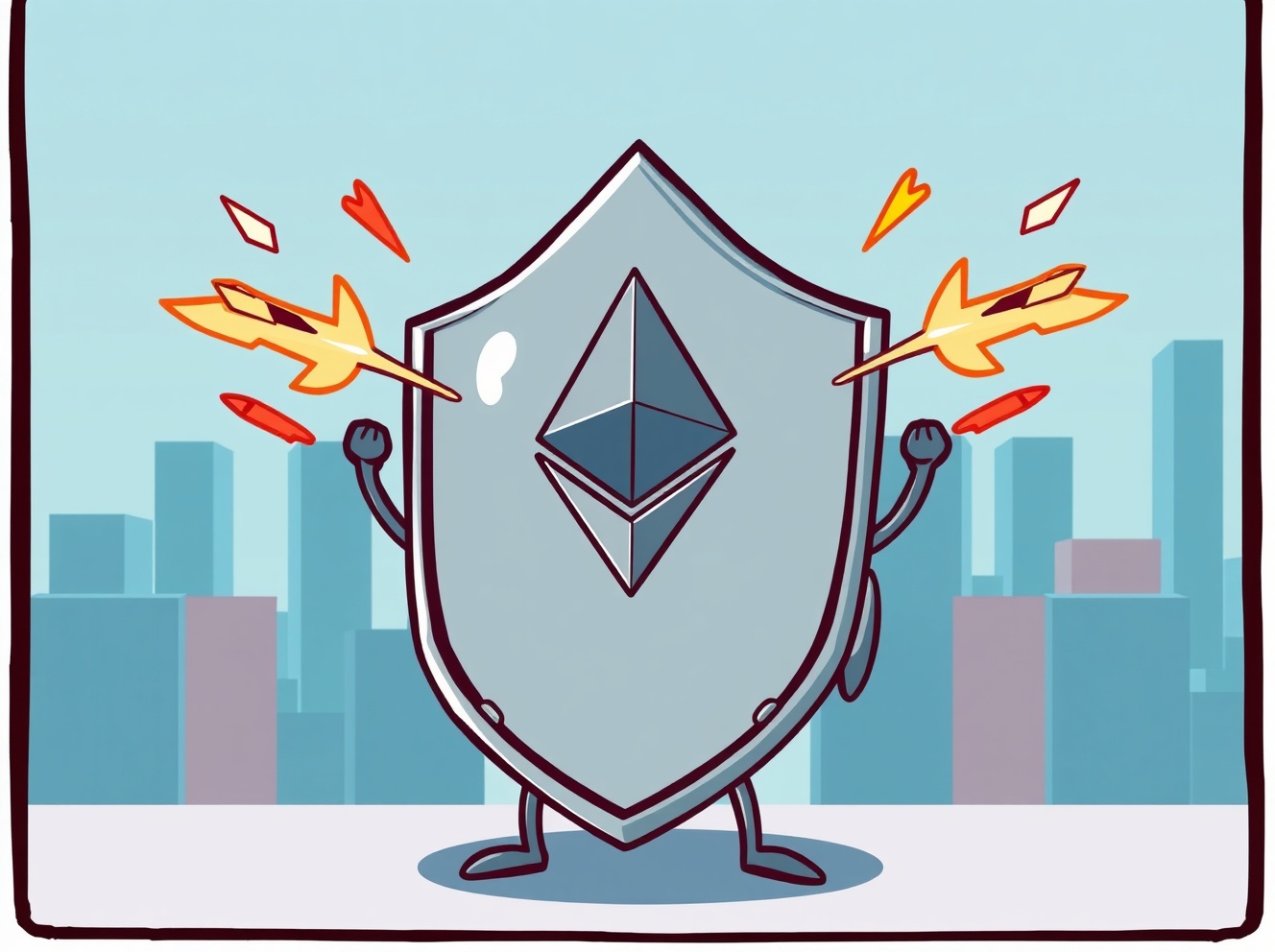Revolutionary ZK Proofs Fusion: Vitalik Buterin’s Bold Plan to Transform Blockchain Security

Share:
BitcoinWorld
Revolutionary ZK Proofs Fusion: Vitalik Buterin’s Bold Plan to Transform Blockchain Security
Imagine a world where your blockchain transactions become virtually unhackable while maintaining complete privacy. Ethereum co-founder Vitalik Buterin just proposed exactly that through a groundbreaking approach to ZK proofs integration. His visionary plan could redefine how we think about cryptographic security across the entire blockchain ecosystem.
What Makes Buterin’s ZK Proofs Proposal So Revolutionary?
Buterin’s innovative framework combines ZK proofs with three other powerful cryptographic technologies. This multi-layered approach creates a security architecture that’s greater than the sum of its parts. The proposal specifically integrates zero-knowledge proofs with multi-party computation, fully homomorphic encryption, and trusted execution environments.
This cryptographic fusion addresses key limitations in current blockchain security systems. Instead of relying on a single method, Buterin’s approach creates redundancy and complementary strengths. Each technology covers weaknesses in the others, resulting in a more robust overall solution.
How Do These Cryptographic Technologies Work Together?
The magic happens through careful orchestration of different security layers. ZK proofs provide the foundation for privacy-preserving verification. Meanwhile, the other technologies enhance specific aspects of the security framework:
- Multi-party computation (MPC) enables multiple parties to jointly compute functions without revealing their inputs
- Fully homomorphic encryption (FHE) allows computation on encrypted data without decryption
- Trusted execution environments (TEEs) provide hardware-level security for sensitive operations
This combination creates a comprehensive security solution that protects data at every stage of processing. The integrated approach ensures that even if one layer faces challenges, the others maintain system integrity.
Why Are Voting Systems the Perfect Application for ZK Proofs Fusion?
Buterin specifically highlighted voting systems as a prime use case for this technology combination. Modern voting requires three crucial elements: verifiability, privacy, and security. Traditional systems struggle to deliver all three simultaneously.
The ZK proofs integration solves this trilemma beautifully. Voters can verify their votes were counted correctly without revealing their choices. The system prevents double-voting while maintaining complete ballot secrecy. Moreover, the multi-layered security makes tampering virtually impossible.
This application demonstrates the real-world impact of Buterin’s proposal. It shows how advanced cryptography can solve practical problems that affect millions of people.
What Challenges Does This ZK Proofs Approach Face?
Despite its promise, the technology faces several implementation hurdles. The computational requirements for running multiple cryptographic systems simultaneously remain significant. However, ongoing hardware improvements and optimization techniques are rapidly addressing these concerns.
Another challenge involves standardization and interoperability. Different blockchain platforms may implement the technology stack differently. The community will need to establish common protocols to ensure seamless integration across ecosystems.
Nevertheless, the potential benefits far outweigh these challenges. As the technology matures, we can expect to see broader adoption across various blockchain applications.
How Will This ZK Proofs Evolution Impact Blockchain’s Future?
Buterin’s proposal represents a significant leap forward in blockchain security architecture. The integrated approach to ZK proofs could become the new gold standard for privacy-focused applications. This evolution marks a shift from single-solution thinking to comprehensive security frameworks.
The implications extend far beyond voting systems. This technology could revolutionize:
- Financial transactions and DeFi protocols
- Identity management systems
- Supply chain verification
- Healthcare data sharing
- Government record keeping
Each application benefits from the enhanced privacy and security that this cryptographic fusion provides.
Conclusion: A New Era of Cryptographic Security Dawns
Vitalik Buterin’s proposal to combine ZK proofs with other cryptographic methods represents a watershed moment for blockchain technology. This integrated approach addresses fundamental security challenges while opening new possibilities for privacy-preserving applications. The voting system example demonstrates the immediate practical value, but the potential applications are virtually limitless.
As the technology develops and overcomes implementation challenges, we can expect to see this cryptographic framework become standard across the blockchain ecosystem. Buterin’s vision points toward a future where digital interactions are both completely transparent where needed and perfectly private where required.
Frequently Asked Questions
What are ZK proofs in simple terms?
ZK proofs let you prove you know something without revealing what that something is. Think of it like proving you have a password without actually showing the password.
Why combine ZK proofs with other technologies?
Each cryptographic method has strengths and weaknesses. Combining them creates a more complete security solution that covers various attack vectors and use cases.
How soon can we see this technology implemented?
Early implementations might appear within 1-2 years, but widespread adoption will likely take longer as the technology matures and standards develop.
Will this make blockchain transactions more expensive?
Initially yes, but optimization and hardware improvements should reduce costs over time, making the technology accessible for broader applications.
Can this technology be used outside blockchain?
Absolutely. The cryptographic principles apply to any system requiring verified privacy, including traditional databases, voting systems, and identity management.
What’s the biggest barrier to adoption?
Computational complexity and the need for industry-wide standards present the most significant current challenges to widespread implementation.
Found this insight into Vitalik Buterin’s revolutionary ZK proofs proposal valuable? Share this article with your network to spread knowledge about the future of blockchain security. Together, we can build a more secure digital world.
To learn more about the latest Ethereum trends, explore our article on key developments shaping Ethereum institutional adoption.
This post Revolutionary ZK Proofs Fusion: Vitalik Buterin’s Bold Plan to Transform Blockchain Security first appeared on BitcoinWorld.
Revolutionary ZK Proofs Fusion: Vitalik Buterin’s Bold Plan to Transform Blockchain Security

Share:
BitcoinWorld
Revolutionary ZK Proofs Fusion: Vitalik Buterin’s Bold Plan to Transform Blockchain Security
Imagine a world where your blockchain transactions become virtually unhackable while maintaining complete privacy. Ethereum co-founder Vitalik Buterin just proposed exactly that through a groundbreaking approach to ZK proofs integration. His visionary plan could redefine how we think about cryptographic security across the entire blockchain ecosystem.
What Makes Buterin’s ZK Proofs Proposal So Revolutionary?
Buterin’s innovative framework combines ZK proofs with three other powerful cryptographic technologies. This multi-layered approach creates a security architecture that’s greater than the sum of its parts. The proposal specifically integrates zero-knowledge proofs with multi-party computation, fully homomorphic encryption, and trusted execution environments.
This cryptographic fusion addresses key limitations in current blockchain security systems. Instead of relying on a single method, Buterin’s approach creates redundancy and complementary strengths. Each technology covers weaknesses in the others, resulting in a more robust overall solution.
How Do These Cryptographic Technologies Work Together?
The magic happens through careful orchestration of different security layers. ZK proofs provide the foundation for privacy-preserving verification. Meanwhile, the other technologies enhance specific aspects of the security framework:
- Multi-party computation (MPC) enables multiple parties to jointly compute functions without revealing their inputs
- Fully homomorphic encryption (FHE) allows computation on encrypted data without decryption
- Trusted execution environments (TEEs) provide hardware-level security for sensitive operations
This combination creates a comprehensive security solution that protects data at every stage of processing. The integrated approach ensures that even if one layer faces challenges, the others maintain system integrity.
Why Are Voting Systems the Perfect Application for ZK Proofs Fusion?
Buterin specifically highlighted voting systems as a prime use case for this technology combination. Modern voting requires three crucial elements: verifiability, privacy, and security. Traditional systems struggle to deliver all three simultaneously.
The ZK proofs integration solves this trilemma beautifully. Voters can verify their votes were counted correctly without revealing their choices. The system prevents double-voting while maintaining complete ballot secrecy. Moreover, the multi-layered security makes tampering virtually impossible.
This application demonstrates the real-world impact of Buterin’s proposal. It shows how advanced cryptography can solve practical problems that affect millions of people.
What Challenges Does This ZK Proofs Approach Face?
Despite its promise, the technology faces several implementation hurdles. The computational requirements for running multiple cryptographic systems simultaneously remain significant. However, ongoing hardware improvements and optimization techniques are rapidly addressing these concerns.
Another challenge involves standardization and interoperability. Different blockchain platforms may implement the technology stack differently. The community will need to establish common protocols to ensure seamless integration across ecosystems.
Nevertheless, the potential benefits far outweigh these challenges. As the technology matures, we can expect to see broader adoption across various blockchain applications.
How Will This ZK Proofs Evolution Impact Blockchain’s Future?
Buterin’s proposal represents a significant leap forward in blockchain security architecture. The integrated approach to ZK proofs could become the new gold standard for privacy-focused applications. This evolution marks a shift from single-solution thinking to comprehensive security frameworks.
The implications extend far beyond voting systems. This technology could revolutionize:
- Financial transactions and DeFi protocols
- Identity management systems
- Supply chain verification
- Healthcare data sharing
- Government record keeping
Each application benefits from the enhanced privacy and security that this cryptographic fusion provides.
Conclusion: A New Era of Cryptographic Security Dawns
Vitalik Buterin’s proposal to combine ZK proofs with other cryptographic methods represents a watershed moment for blockchain technology. This integrated approach addresses fundamental security challenges while opening new possibilities for privacy-preserving applications. The voting system example demonstrates the immediate practical value, but the potential applications are virtually limitless.
As the technology develops and overcomes implementation challenges, we can expect to see this cryptographic framework become standard across the blockchain ecosystem. Buterin’s vision points toward a future where digital interactions are both completely transparent where needed and perfectly private where required.
Frequently Asked Questions
What are ZK proofs in simple terms?
ZK proofs let you prove you know something without revealing what that something is. Think of it like proving you have a password without actually showing the password.
Why combine ZK proofs with other technologies?
Each cryptographic method has strengths and weaknesses. Combining them creates a more complete security solution that covers various attack vectors and use cases.
How soon can we see this technology implemented?
Early implementations might appear within 1-2 years, but widespread adoption will likely take longer as the technology matures and standards develop.
Will this make blockchain transactions more expensive?
Initially yes, but optimization and hardware improvements should reduce costs over time, making the technology accessible for broader applications.
Can this technology be used outside blockchain?
Absolutely. The cryptographic principles apply to any system requiring verified privacy, including traditional databases, voting systems, and identity management.
What’s the biggest barrier to adoption?
Computational complexity and the need for industry-wide standards present the most significant current challenges to widespread implementation.
Found this insight into Vitalik Buterin’s revolutionary ZK proofs proposal valuable? Share this article with your network to spread knowledge about the future of blockchain security. Together, we can build a more secure digital world.
To learn more about the latest Ethereum trends, explore our article on key developments shaping Ethereum institutional adoption.
This post Revolutionary ZK Proofs Fusion: Vitalik Buterin’s Bold Plan to Transform Blockchain Security first appeared on BitcoinWorld.







